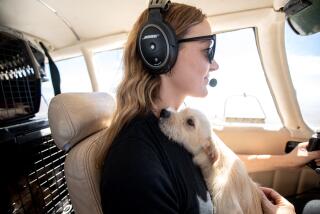Flying Like a Bird : One Try at Soaring and She Was Hooked for Life
- Share via
WARNER SPRINGS, Calif. — Polly Ridgway has what she calls a very serious habit.
She developed it about 7 1/2 years ago and now has to get a “fix” for her habit at least five times a day. For Ridgway, 27, her addiction is experiencing something usually reserved for eagles and hawks: soaring.
Birds do it with wings. Ridgway uses a sailplane to glide through the sky with nothing more than the wind and rising air to propel her above Warner Springs Valley, where she teaches other people how to soar.
At the Warner Springs Soaring Center--off California 79 about 30 miles northeast of Escondido--Ridgway takes up an average of 25 people a week in a sailplane or glider, which the craft are also called.
“My friend took me for a ride in a sailplane and that was the end of it,” said Ridgway, who lives in Julian with her husband, Paul. “It didn’t take me long to realize that I’d have to get a job in the flying field.
“You see, I developed a very serious flying habit,” said Ridgway, who has a commercial glider pilot’s license, but not a conventional airplane pilot’s permit.
There are glider ports in the Otay Lakes area of San Diego and at Torrey Pines, but the Warner Springs port is the only spot in the county where the general public can pay for a ride in a sailplane. It’s $20 for a 20-minute ride about 6,000 feet above the gentle pastures and rocky terrain of the valley.
The valley, with Lake Henshaw and Palomar Mountain to the west and Hot Springs Peak to the east, is an ideal spot for gliding because of the constant pockets of heat rising from the ground, according to gliding enthusiasts who frequent the park.
The rising columns of heat--known as thermals--allow the sailplane, once it is towed by a single-engine plane to an altitude of about 3,000 feet, to glide for up to two hours at speeds of about 60 m.p.h. and to ascend as fast as 400 feet per minute.
At Warner Springs a converted crop-dusting plane is used to tow the gliders into the air.
The sleek aluminum and fiberglass craft, which weigh only about 600 pounds and have a 50-foot wingspan, appear to blend into the horizon from a distance. They are so aerodynamically clean that a sailplane has a glide ratio of 22 to 1, which means that for every foot the plane descends it is capable of gliding forward 22 feet. In comparison, a modern jet has a glide ratio of about 4 to 1.
As the glider descends, the pilot usually maneuvers the craft toward the 1,000-foot asphalt runway and, hopefully, a gentle landing. But if the plane begins to descend rapidly and the runway is too far away, that’s OK because a glider can land in any number of pastures without much danger, Ridgway said.
There are other addicts.
Take Dewey Hill, a 67-year-old retired tool and die maker from Michigan who spends his winters at Salton Sea. He’s been flying small airplanes since 1942, but says that it wasn’t until three years ago, when he first tried soaring, that he knew what it feels like to be a bird.
‘It’s the Real Thing’
“This is getting back to real flying,” Hill said as he climbed aboard a sailplane. “It’s the real thing. No qualms about a forced landing in this thing because every landing is forced in a sailplane.”
Although Ridgway took her first soaring ride 7 1/2 years ago, it wasn’t until the summer of 1980, when she was working as a computer operator in San Diego, that she got her first opportunity to soar every day.
“A friend called me at work after I had been there only five months and said he needed someone to help with a soaring port in the Owens Valley for the summer,” she said. “I told him I’d have to think about it. . . . I called him back five minutes (later).
“That’s the last time I had a straight job.”
After a summer of teaching soaring in the Owens Valley, Ridgway returned to San Diego and hooked up with Jim McDonald, who was then operating a glider port at Otay Lakes and who later took over operation of the Warner Spring Soaring Center. Ridgway has been working for McDonald since then.
Tries to Imitate Hawks
For Ridgway, it is the free feeling of floating through the sky in a winged craft without an engine that fuels her addiction. Red-tailed hawks can be seen from the valley floor catching thermals and spiraling upward. This is what Ridgway and other gliders attempt to imitate.
To catch the smooth upswing of a strong thermal and watch the altimeter (an instrument that monitors height) “tick like the second hand on a clock” is the ideal situation. The highest Ridgway has soared is 18,000 feet. Oxygen masks are required at heights above 12,000 feet.
“A few months ago I got up to about 9,000 feet and saw this bird in a thermal,” she said. “I maneuvered over to the thermal and saw that it was a golden eagle. We were right next to him and he just turned his head around and looked at us.
“I was wishing I had a camera.”
More to Read
Sign up for The Wild
We’ll help you find the best places to hike, bike and run, as well as the perfect silent spots for meditation and yoga.
You may occasionally receive promotional content from the Los Angeles Times.






